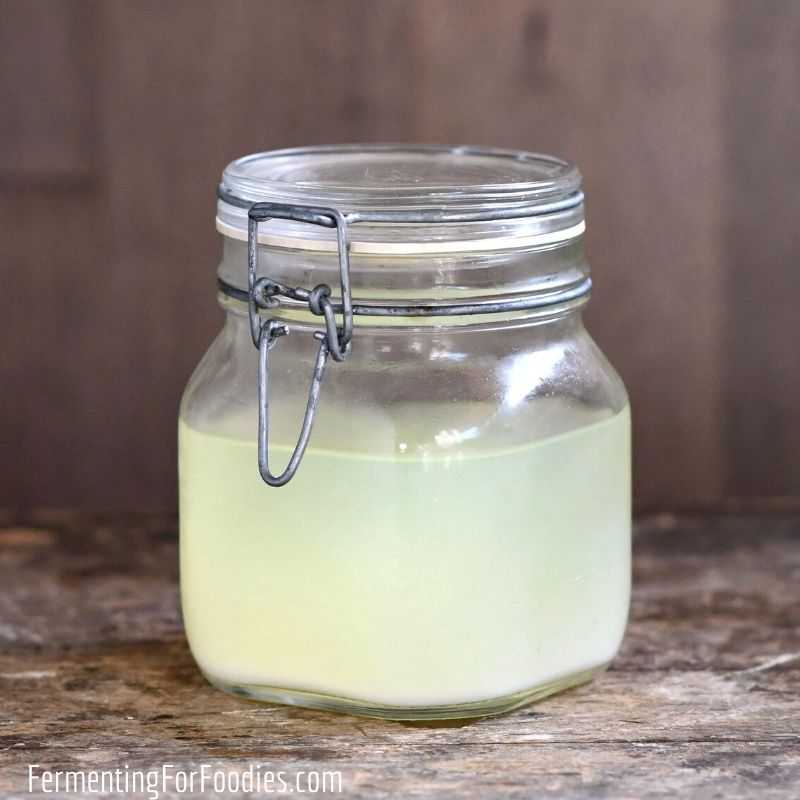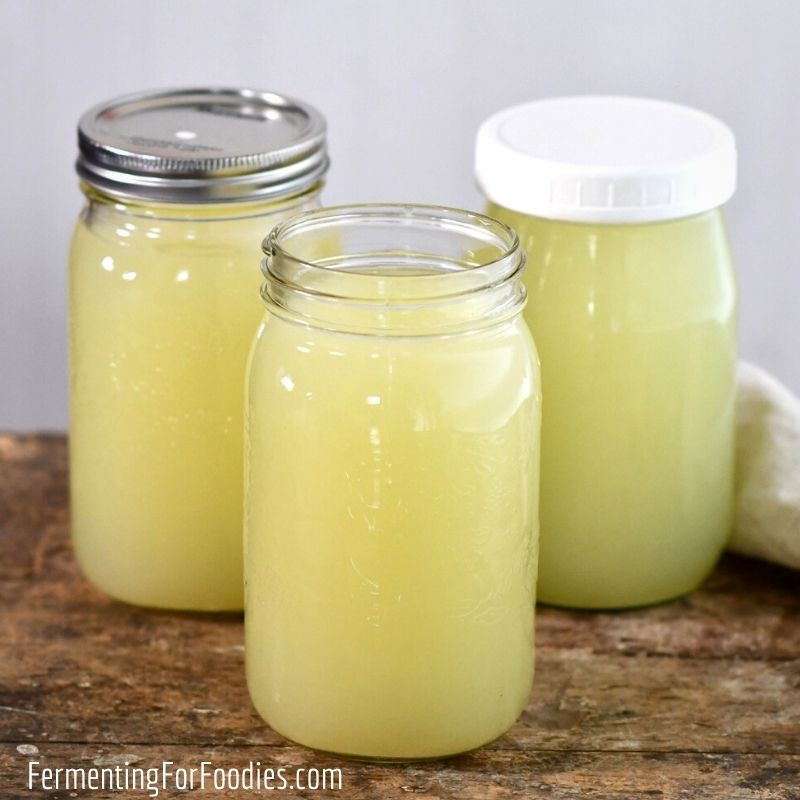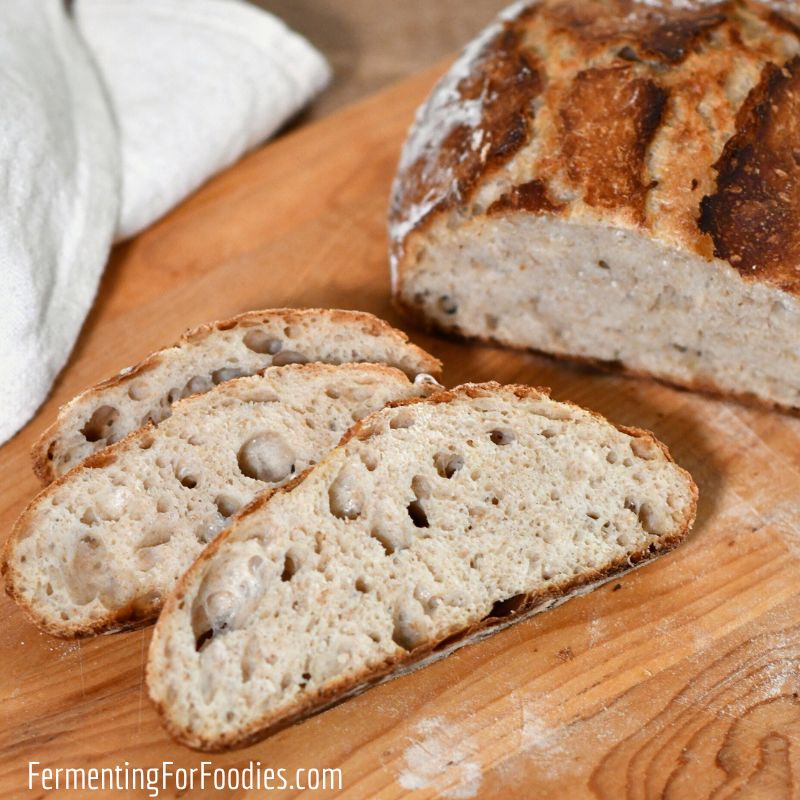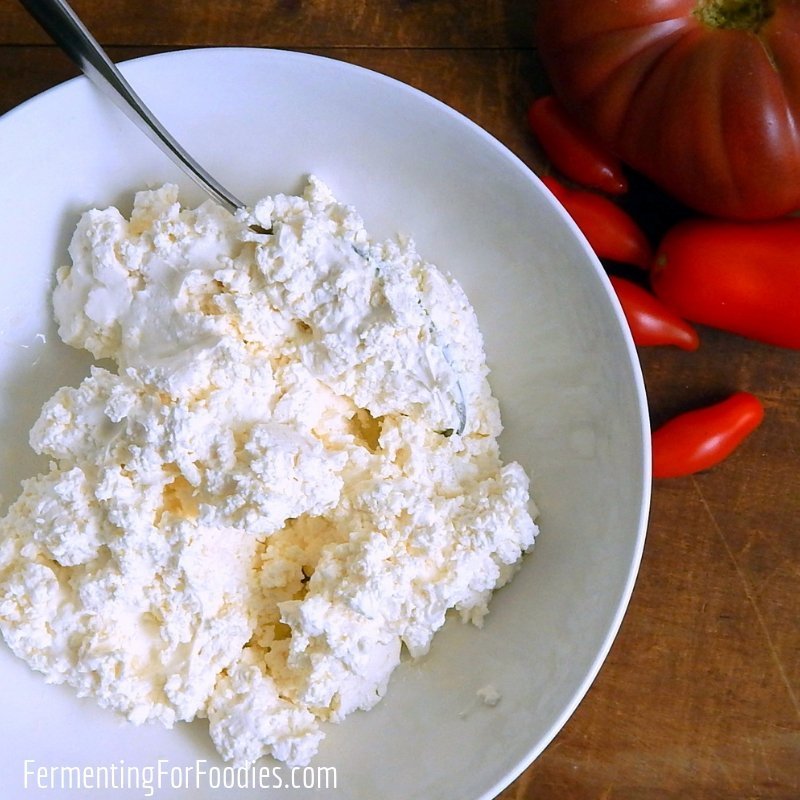Wondering how to use whey from making cheese or strained yogurt? Don’t pour it down the drain! Here are 28 different recipes and ideas for using whey.

Types of whey
Whey is comprised of water, lactose, and whey proteins. The flavor and sourness varies depending on how it was made.
There are essentially three types:
- Acid whey comes from cheese made with citric acid or vinegar. It is very in high lactose (milk sugar) and is quite sour. It is not probiotic and cannot be used to make fermented foods.
- Sweet whey is a by-product of making firm cheese. Basically, any cheese that is cultured for less than 3 hours, will have sweet-tasting whey right after draining. After that, it becomes more acidic as the lactose is consumed by the Lacto-bacteria. Storing sweet whey in the fridge will slow the acidification, but only for about 12 hours. It is probiotic and lower in lactose.
- Sour whey is sweet whey that is older than 12 hours or drained from cheeses that have a long culturing period. This includes Greek yogurt, kefir cheese, and cottage cheese. It is very acidic and low in lactose.
Here is how to use up leftover whey. I’ve divided it up by type since they each have their own unique properties.

Recipes and ideas for All types of whey
Soups and Stews
One of the best ways to use up leftover whey is as a broth. Replace up to 1/4 of the broth or water in a recipe with whey. It adds richness, protein, and tanginess that really brings out the flavors of the other ingredients.

Here are three soups that are specifically designed to use up leftover whey:
Other Dishes
- Homemade cheese sauce
- Risotto
- Mashed potatoes
- Scalloped potatoes
- Polenta or grits
- Millet
- Corn tortillas
- Waffles
Baking
Whey is perfect for any recipe that calls for buttermilk. It’s not as thick as buttermilk, so stick to recipes where the exact amount of liquid doesn’t matter. (It’s why I don’t recommend it for pancakes or biscuits).

Here are a few baked goods to try:
- Oatmeal muffins
- Apple coffee cake
- Soda bread
- Cornbread
- Flax seed crackers
- Whey bread is a yeasted loaf. The whey gives a delicious sourdough-like flavor to the bread.
Treats!
Whey can be used instead of water for all sorts of treats and desserts. Here are a few examples:
How to use cultured whey (Sweet or Sour)
For fermenting
Sweet or sour whey from making cultured cheese is full of Lacto bacteria. It is perfect for fermenting all sorts of things. Most grains, legumes, nuts, and vegetables will ferment faster with a starter.
Try making:
- Berry sauce
- Chia seed jam
- Relish
- Pickled onions
- Milk kefir sodas
Around the house
The probiotic culture is also useful around the house:
- Water your acid-loving plants (in particular, rhododendrons and blueberries).
- Presoak beans and grains to soften them before cooking. The acidity prevents the skin of the bean from breaking down, so it’s perfect for dishes like my black bean korma, but not recommended for hummus.
- Feed it to your dogs/pigs/chickens.
- Make a bubble bath. Add it when you fill your tub and it will bubble up! The probiotics are great for your skin.
- Add it to your compost pile (though only in limited amounts as too much acid or liquid isn’t recommended).
How to use sweet whey
As a drink
Fresh sweet whey from cheesemaking is actually quite sweet. My kids like to drink it straight or mix it into a yummy beverage.
It is really only sweet for the first few hours, so take a break from cleaning the kitchen and enjoy a beverage while your cheese finishes draining.
Here are a few drinks to enjoy!
- Hot chocolate
- Chai tea latte
- Ovaltine
- Smoothies!
Whey Cheeses

There are a few kinds of cheese that can be made from fresh sweet whey. So you need to make them right after finishing your first batch of cheese.


I have no access to sweet whey, but all the sour whey I could possibly want. Is there ANYTHING??? I can do with it? This whey, both cow and goat milk, is a byproduct of the fresh cheeses made in a local creamery. They all use starter bacteria, they all use rennet, but the whey is not considered sweet. Thanks in advance for any advice or help!
~Allen
I imagine that you’re getting it 24 hours or so after the cheesemaking process, which is why it is quite sour (it acidifies over time.) However, if they aren’t curdling it with acid, then it will still be good for most of these recipes. Try one of the soups adding just 1 cup of whey at a time to see how much you can use before it becomes too sour. It is also perfect for baking. The only thing you can’t do with cultured sour whey is make a sweet whey cheese.
If you are in the milk kefir habit, you can make sweet whey using unseparated milk kefir.
Hi Jon, Sweet whey is from milk that is only cultured for 3 hours or less. While you can make a sweeter flavored whey with milk kefir, it won’t technically be “sweet whey”. So you won’t be able to use it for whey-based cheeses. However, you can use it for all sorts of other recipes. Cheers!
Hi! How long will whey keep in the fridge?
Whey is only sweet if it is the first 3 hours after fermenting. However, acid whey from cultured cheese or yogurt should last 2 weeks in the fridge because of the bacterial culture. If you made cheese with acid (lemon juice, vinegar, citric acid) then I would use the whey within 1 week.
Will it remain sweet if I immediately freeze the whey from making Greek yogurt? That way I am collecting enough to use.
Unfortunately, whey from Greek yogurt is always an acid whey since the yogurt has already cultured for more than 3 hours (and acidified). So you won’t be able to use it to make ricotta. However, you can freeze it for smoothies, soups and other uses. Enjoy!
Per Wikipedia, Whey is the liquid remaining after milk has been curdled and strained. It is a byproduct of the manufacture of cheese or casein and has several commercial uses. Sweet whey is a byproduct resulting from the manufacture of rennet types of hard cheese, like cheddar or Swiss cheese. Acid whey (also known as sour whey) is a byproduct brought out during the making of acid types of dairy products, such as cottage cheese or strained yogurt.
You mentioned above that: Sweet whey is made from cultured dairy. This statement conflicts with what Wikipedia is saying. Can you please clarify. Thanks.
Hi, The difference between sweet whey and acid whey has been really hard to get across to readers. Mostly because a lot of people want to use their whey from Greek yogurt as sweet whey (when it isn’t.) 🙂
Hard cheeses are also cultured, but what makes the whey sweet is that it is only a few hours old (including the culturing time.) Even whey from hard cheese becomes acidic over time, as the bacterial culture continues to eat up sugars and acidify the whey. Thus sweet whey will turn into acidic whey within less than 24 hours. I think Wikipedia is just giving an easy overview of the topic. Cheers!
Can I use the whey from Greek Yogurt as a starter for sourdough bread?
Sorry… yogurt is just bacteria… sourdough bread needs a yeast-based culture. However you could use it for a quick soda bread: https://www.fermentingforfoodies.com/traditional-irish-soda-bread/
This what I have understood but I might be wrong. Cheese made with culture or without culture will have sweet whey as a byproduct if you curdle it with rennet. If you use some form of live culture it will in time convert to sour whey. If you only use live culture to curdle the milk you only produce sour whey. When using rennet the milk quickly curdles leaving insufficient time for the live culture to effect the balance of lactose in the why. Did I miss anything? Thanks
Yes, time is key to sweet versus sour whey. I get a lot of questions from people who make Greek yogurt and think that because they are using the whey right after draining that it is sweet. But whey from yogurt can never be sweet. 🙂
Hi
I got whey when I meant to make butter milk by taking about a half cup of my previous batch, and maybe left it too long. It separated. So I strained it like you would for cheese. I ended up with a ricotto/cream cheese type cheese. And noticed that after I had refrigerated the whey it had a slightly slimy consistency to it. Is this normal? and ok to consume?
Hum, slightly slimy is unusual. Sometimes cultured whey can be thick due to the bacteria (or yeast from milk kefir). Milk that has gone off usually smells bad. So if it doesn’t smell bad, then you could give it a little taste, and if it doesn’t taste bad, it’s probably fine. Most likely just thick from the bacterial culture in your buttermilk. Good luck!
Soaking beans in acid would extend the cooking times. using baking soda instead, which is basic in ph, has the opposite effect.
Good point! I like to add baking soda to my beans when I’m planning to puree them because it breaks down the tough skin for an extra creamy bean (like in my hummus recipe). Acid prevents the skin from breaking down, so it’s good if you want to maintain the structure of the bean. (Like in a bean curry). Cheers!
Used this to make mushroom risotto and also quinoa
Yum! I love whey risotto, but haven’t tried it with quinoa. Will do that with my next batch of cheese. 🙂
Any recommendations for what to make with keffir whey specifically?
I use it for baking and making sourdough like bread, etc. If you search the site for milk kefir, I’m sure you’ll plenty of recipes. 😉 Honestly, I make it all the time! Cheers, Emillie
Hi I made a cottage-like cheese from fresh whole milk and buttermilk. According to a recipe I was following I was supposed to add a tablespoon of vinegar towards the end which would result in larger curds. Does this mean I can no longer use this whey for fermentation?
The recipe was 1 gallon fresh whole milk, 1 qt buttermilk and 1tbsp of white vinegar at the end. Thanks
If the whey was originally cultured with buttermilk (typical for cottage cheese) then it will be full of good cultures. However, adding vinegar will make it more acidic. So it won’t taste as nice in soups, baking, etc. The added vinegar is too little to stop fermentation. So no worries there! I make cottage cheese all the time but have never added vinegar. The milk should clabber just fine with buttermilk. If it doesn’t, then the buttermilk doesn’t have an active culture.
Is the vinegar being used as an alternative to rennet (it’s not the same, but I don’t understand why it’s being added)? I have made my recipe without rennet, though I recommend using rennet because the yield is better: https://www.fermentingforfoodies.com/homemade-cottage-cheese/
Cheers, Emillie
hi, I make my own cottage cheese from cultured milk we call Maas in South Africa. the whey I use in baking and cooking. I was wondering if I could use the whey instead of milk when I make kefir? I have the milk scobie not the water scobie. thanks for all the extra ideas.
Hi Sylvia, Since Maas is made from cultured dairy, it will already have plenty of culture. If you wanted to drink it as a cultured beverage, you could! Don’t reculture it with kefir grains. You’ll risk contaminating the grains with the bacterial strains in Maas. Also, most of the lactose will have already been consumed, leaving very little for the kefir grains to eat.
Cheers, Emillie